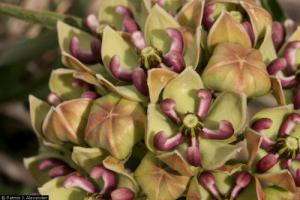Because the larvae of Monarch butterfly feed on spider milkweed and ingest its poisonous, milky sap, they are distasteful to birds trying to make a meal out of them or their butterflies. Many milkweed plants can be poisonous to livestock and other animals, including humans
Photo Credit: © Patrick J. Alexander, USDA-NRCS PLANTS Database.
Asclepias asperula
Common Name: spider milkweed
Other Common Names: antelope horns, antelopehorn milkweed, spider antelope-horns
Plant Functional Group: Forb
Class > Order > Family: Magnoliopsida > Gentianales > Apocynaceae
What does the species look like?
Spider milkweed is an erect to spreading, perennial, herbaceous plant growing 6 to 24 inches tall. Its small, pale yellowish-green and purplish flowers have both male and female parts, and are grouped into showy, globose clusters at the top of the stems.
Spider milkweed grows in well-drained but moist, rocky or sandy soils of prairies and plains, hillsides, brushlands, woodlands, trails, and roadsides.
Where is the species found?
States & Provinces
AZ, CA, CO, ID, KS, NE, NM, NV, OK, TX, UT
Special Considerations for Observing
If drought seems to be the cause of leaf senescence for a plant, please make a comment about it for that observation.
Which phenophases should I observe?
Do you see...?
Leaves
Initial growth More...
Leaves More...
Flowers
Flowers or flower buds More...
How many flowers and flower buds are present? For species in which individual flowers are clustered in flower heads, spikes or catkins (inflorescences), simply estimate the number of flower heads, spikes or catkins and not the number of individual flowers.
Less than 3 3 to 10 11 to 100 101 to 1,000 More than 1,000
Open flowers More...
What percentage of all fresh flowers (buds plus unopened plus open) on the plant are open? For species in which individual flowers are clustered in flower heads, spikes or catkins (inflorescences), estimate the percentage of all individual flowers that are open.
Less than 5% 5-24% 25-49% 50-74% 75-94% 95% or more
Fruits
Fruits Asclepias asperula , the fruit is large and pod-like and changes from green to tan or brown and splits open to expose seeds with fluff. Do not include empty fruits that have already dropped all of their seeds.More...
How many fruits are present?
Less than 3 3 to 10 11 to 100 101 to 1,000 More than 1,000
Ripe fruits Asclepias asperula , a fruit is considered ripe when it has turned tan or brown and has split open to expose seeds with fluff. Do not include empty fruits that have already dropped all of their seeds.More...
What percentage of all fruits (unripe plus ripe) on the plant are ripe?
Less than 5% 5-24% 25-49% 50-74% 75-94% 95% or more
Recent fruit or seed drop More...
How many mature fruits have dropped seeds or have completely dropped or been removed from the plant since your last visit?
Less than 3 3 to 10 11 to 100 101 to 1,000 More than 1,000
What do these phenophases look like?
There is currently no photoguide available for this species. If you'd like help us create one, use the guidance document and species template provided here . Then send it via email to education@usanpn.org when it is complete.
